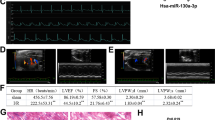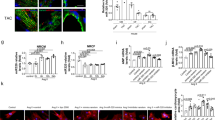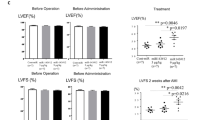Abstract
To examine microRNA-133a (miR-133a) endogenous expression in cardiomyocytes after ischemia-reperfusion (I/R) injury and study the effects of miR-133a overexpression on I/R injury-induced cardiomyocyte apoptosis. Dual-Luciferase Reporter Assay detected dynamic expression of miR-133a. In an in vitro hypoxia-reoxygenation (HR) injury model and an in vivo rat model of I/R injury, rat cardiomyocytes were transfected with miR-133a mimic to test the effects of miR-133a overexpression on apoptosis. MiR-133a and Death Associated Protein Kinase 2 (DAPK2) mRNA expression was measured using real-time-PCR, and DAPK2 protein expression was detected by western blotting. Annexin V-fluorescein isothiocyanate/propidium iodide (PI) double-staining measured the apoptosis rate in H9C2 cells and transferase dUTP nick end labeling assay quantified the cardiomyocyte apoptosis rate in tissues obtained from in vivo the rat model. DAPK2 is a target of miR-133a. Both in vitro and in vivo results confirmed that after expression of miR-133a mimics, miR-133a levels increased, which was accompanied by decrease in DAPK2 mRNA and protein expression. In H9C2 cells, HR injury caused a sharp decrease in miR-133a expression and a significant upregualtion of DAPK2 mRNA and protein levels. However, exogenous miR-133a expression led to a significant reduction in DAPK2 mRNA and protein levels despite HR injury. Similar results were obtained from in vivo I/R injury model. After HR injury or I/R injury the apoptosis rate of myocardial cells was highly elevated and decreased significantly only after transfection of miR-133a into cardiomyocytes. MiR-133a overexpression may inhibit I/R injury-mediated cardiomyocyte apoptosis by targeting DAPK2, leading to reduced DAPK2 protein, thus miR-133a may potentially have a high therapeutic value in I/R injury.
Similar content being viewed by others
Log in or create a free account to read this content
Gain free access to this article, as well as selected content from this journal and more on nature.com
or
References
Mathers, C. D. & Loncar, D. Projections of global mortality and burden of disease from 2002 to 2030. PLoS Med 3, e442 (2006).
Hausenloy, D. J. & Yellon, D. M. Myocardial ischemia-reperfusion injury: a neglected therapeutic target. J. Clin. Invest. 123, 92–100 (2013).
Frank, A., Bonney, M., Bonney, S., Weitzel, L., Koeppen, M. & Eckle, T. Myocardial ischemia reperfusion injury: from basic science to clinical bedside. Semin. Cardiothorac. Vasc. Anesth 16, 123–132 (2012).
Canty, J. M. Jr & Suzuki, G. Myocardial perfusion and contraction in acute ischemia and chronic ischemic heart disease. J. Mol. Cell. Cardiol. 52, 822–831 (2012).
Frohlich, G. M., Meier, P., White, S. K., Yellon, D. M. & Hausenloy, D. J. Myocardial reperfusion injury: looking beyond primary PCI. Eur. Heart J 34, 1714–1722 (2013).
Diez, E. R., Altamirano, L. B., Garcia, I. M., Mazzei, L., Prado, N. J., Fornes, M. W. et al. Heart remodeling and ischemia-reperfusion arrhythmias linked to myocardial vitamin d receptors deficiency in obstructive nephropathy are reversed by paricalcitol. J. Cardiovasc. Pharmacol. Ther. 20, 211–220 (2014).
Hausenloy, D. J. & Yellon, D. M. The therapeutic potential of ischemic conditioning: an update. Nat. Rev. Cardiol. 8, 619–629 (2011).
Dongworth, R. K., Mukherjee, U. A., Hall, A. R., Astin, R., Ong, S. B., Yao, Z. et al. DJ-1 protects against cell death following acute cardiac ischemia-reperfusion injury. Cell Death Dis 5, e1082 (2014).
Siddall, H. K., Yellon, D. M., Ong, S. B., Mukherjee, U. A., Burke, N., Hall, A. R. et al. Loss of PINK1 increases the heart's vulnerability to ischemia-reperfusion injury. PLoS One 8, e62400 (2013).
Ren, X. P., Wu, J., Wang, X., Sartor, M. A., Qian, J., Jones, K. et al. MicroRNA-320 is involved in the regulation of cardiac ischemia/reperfusion injury by targeting heat-shock protein 20. Circulation 119, 2357–2366 (2009).
Cheng, Y., Zhu, P., Yang, J., Liu, X., Dong, S., Wang, X. et al. Ischaemic preconditioning-regulated miR-21 protects heart against ischaemia/reperfusion injury via anti-apoptosis through its target PDCD4. Cardiovasc. Res. 87, 431–439 (2010).
Di, Y., Lei, Y., Yu, F., Changfeng, F., Song, W. & Xuming, M. MicroRNAs expression and function in cerebral ischemia reperfusion injury. J. Mol. Neurosci 53, 242–250 (2014).
Tutar, L., Tutar, E. & Tutar, Y. MicroRNAs and cancer; an overview. Curr. Pharm. Biotechnol. 15, 430–437 (2014).
Olson, E. N. MicroRNAs as therapeutic targets and biomarkers of cardiovascular disease. Sci. Transl. Med. 6, 239ps3 (2014).
Ye, Y., Perez-Polo, J. R., Qian, J. & Birnbaum, Y. The role of microRNA in modulating myocardial ischemia-reperfusion injury. Physiol. Genomics 43, 534–542 (2011).
Dong, D. L., Chen, C., Huo, R., Wang, N., Li, Z., Tu, Y. J. et al. Reciprocal repression between microRNA-133 and calcineurin regulates cardiac hypertrophy: a novel mechanism for progressive cardiac hypertrophy. Hypertension 55, 946–952 (2010).
Care, A., Catalucci, D., Felicetti, F., Bonci, D., Addario, A., Gallo, P. et al. MicroRNA-133 controls cardiac hypertrophy. Nat. Med. 13, 613–618 (2007).
Fichtlscherer, S., De Rosa, S., Fox, H., Schwietz, T., Fischer, A., Liebetrau, C. et al. Circulating microRNAs in patients with coronary artery disease. Circ. Res. 107, 677–684 (2010).
Kuwabara, Y., Ono, K., Horie, T., Nishi, H., Nagao, K., Kinoshita, M. et al. Increased microRNA-1 and microRNA-133a levels in serum of patients with cardiovascular disease indicate myocardial damage. Circ. Cardiovasc. Genet. 4, 446–454 (2011).
Duisters, R. F., Tijsen, A. J., Schroen, B., Leenders, J. J., Lentink, V., van der Made, I. et al. miR-133 and miR-30 regulate connective tissue growth factor: implications for a role of microRNAs in myocardial matrix remodeling. Circ. Res. 104, 170–178 (2009).
Griffiths-Jones, S. miRBase: microRNA sequences and annotation. Curr. Protoc. Bioinform. Chapter 12, Unit 12.9.1-10 (2010).
Liu, N., Bezprozvannaya, S., Williams, A. H., Qi, X., Richardson, J. A., Bassel-Duby, R. et al. microRNA-133a regulates cardiomyocyte proliferation and suppresses smooth muscle gene expression in the heart. Genes Dev. 22, 3242–3254 (2008).
Xiao, J., Luo, X., Lin, H., Zhang, Y., Lu, Y., Wang, N. et al. MicroRNA miR-133 represses HERG K+ channel expression contributing to QT prolongation in diabetic hearts. J. Biol. Chem. 282, 12363–12367 (2007).
Luo, X., Lin, H., Pan, Z., Xiao, J., Zhang, Y., Lu, Y. et al. Down-regulation of miR-1/miR-133 contributes to re-expression of pacemaker channel genes HCN2 and HCN4 in hypertrophic heart. J. Biol. Chem 283, 20045–20052 (2008).
Vandenberg, J. I., Perry, M. D., Perrin, M. J., Mann, S. A., Ke, Y. & Hill, A. P. hERG K(+) channels: structure, function, and clinical significance. Physiol. Rev 92, 1393–1478 (2012).
Luo, X., Lin, H., Pan, Z., Xiao, J., Zhang, Y., Lu, Y. et al. Down-regulation of miR-1/miR-133 contributes to re-expression of pacemaker channel genes HCN2 and HCN4 in hypertrophic heart. J. Biol. Chem. 286, 28656 (2011).
Livak, K. J. & Schmittgen, T. D. Analysis of relative gene expression data using real-time quantitative PCR and the 2(-Delta Delta C(T)) Method. Methods 25, 402–408 (2001).
Townley-Tilson, W. H., Callis, T. E. & Wang, D. MicroRNAs 1, 133, and 206: critical factors of skeletal and cardiac muscle development, function, and disease. Int. J. Biochem. Cell. Biol. 42, 1252–1255 (2010).
Izarra, A., Moscoso, I., Levent, E., Canon, S., Cerrada, I., Diez-Juan, A. et al. miR-133a enhances the protective capacity of cardiac progenitors cells after myocardial infarction. Stem Cell Rep. 3, 1029–1042 (2014).
Sayed, D., Hong, C., Chen, I. Y., Lypowy, J. & Abdellatif, M. MicroRNAs play an essential role in the development of cardiac hypertrophy. Circ. Res. 100, 416–424 (2007).
Tatsuguchi, M., Seok, H. Y., Callis, T. E., Thomson, J. M., Chen, J. F., Newman, M. et al. Expression of microRNAs is dynamically regulated during cardiomyocyte hypertrophy. J. Mol. Cell. Cardiol. 42, 1137–1141 (2007).
He, B., Xiao, J., Ren, A. J., Zhang, Y. F., Zhang, H., Chen, M. et al. Role of miR-1 and miR-133a in myocardial ischemic postconditioning. J. Biomed. Sci 18, 22 (2011).
Ivey, K. N., Muth, A., Arnold, J., King, F. W., Yeh, R. F., Fish, J. E. et al. MicroRNA regulation of cell lineages in mouse and human embryonic stem cells. Cell Stem Cell 2, 219–229 (2008).
Xu, C., Lu, Y., Pan, Z., Chu, W., Luo, X., Lin, H. et al. The muscle-specific microRNAs miR-1 and miR-133 produce opposing effects on apoptosis by targeting HSP60, HSP70 and caspase-9 in cardiomyocytes. J. Cell Sci. 124, 3187 (2011).
Xu, C., Lu, Y., Pan, Z., Chu, W., Luo, X., Lin, H. et al. The muscle-specific microRNAs miR-1 and miR-133 produce opposing effects on apoptosis by targeting HSP60, HSP70 and caspase-9 in cardiomyocytes. J. Cell Sci. 120, 3045–3052 (2007).
Zhu, H. & Fan, G. C. Role of microRNAs in the reperfused myocardium towards post-infarct remodelling. Cardiovasc. Res. 94, 284–292 (2012).
Lin, Y., Hupp, T. R. & Stevens, C. Death-associated protein kinase (DAPK) and signal transduction: additional roles beyond cell death. FEBS J. 277, 48–57 (2010).
Britschgi, A., Trinh, E., Rizzi, M., Jenal, M., Ress, A., Tobler, A. et al. DAPK2 is a novel E2F1/KLF6 target gene involved in their proapoptotic function. Oncogene 27, 5706–5716 (2008).
Acknowledgements
We would like to acknowledge the reviewers for their helpful comments on this paper.
Author information
Authors and Affiliations
Corresponding author
Ethics declarations
Competing interests
The authors declare no conflict of interest.
Rights and permissions
About this article
Cite this article
Li, S., Xiao, FY., Shan, PR. et al. Overexpression of microRNA-133a inhibits ischemia-reperfusion-induced cardiomyocyte apoptosis by targeting DAPK2. J Hum Genet 60, 709–716 (2015). https://doi.org/10.1038/jhg.2015.96
Received:
Revised:
Accepted:
Published:
Issue date:
DOI: https://doi.org/10.1038/jhg.2015.96
This article is cited by
-
Mechanism of Qili Qiangxin Capsule for Heart Failure Based on miR133a-Endoplasmic Reticulum Stress
Chinese Journal of Integrative Medicine (2024)
-
Cardiovascular Exosomes and MicroRNAs in Cardiovascular Physiology and Pathophysiology
Journal of Cardiovascular Translational Research (2021)
-
MALAT1 knockdown protects from bronchial/tracheal smooth muscle cell injury via regulation of microRNA-133a/ryanodine receptor 2 axis
Journal of Biosciences (2021)
-
The Impact of MicroRNA-133a on Prognosis and Clinicopathological Parameters for Digestive System Cancers: a Comprehensive Study Based on Meta-Analysis and TCGA Database
Pathology & Oncology Research (2020)
-
Integrative analysis of differentially expressed genes and miRNAs predicts complex T3-mediated protective circuits in a rat model of cardiac ischemia reperfusion
Scientific Reports (2018)



